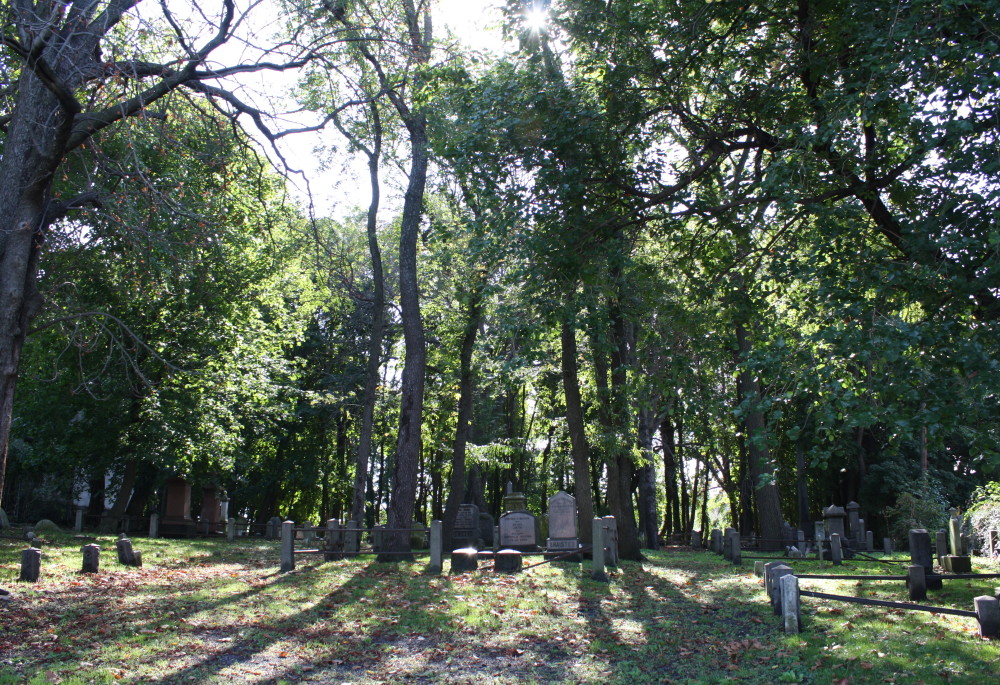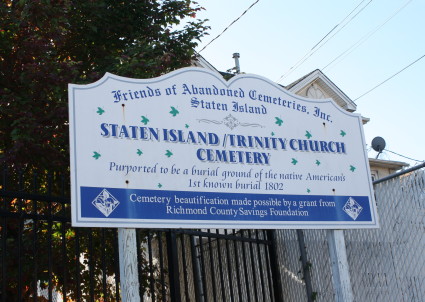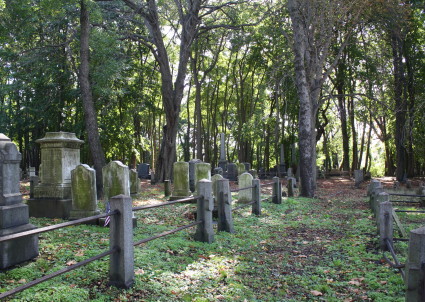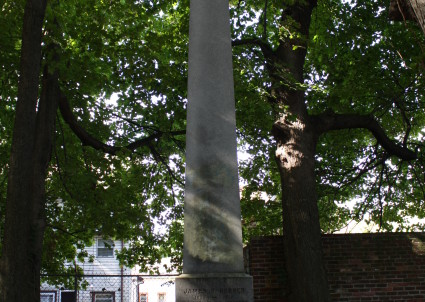Staten Island Cemetery, Trinity Cemetery, Trinity Cemetery, Van Street Cemetery
established 1847
established 1801
established 1863
established 1889
(entrance adjacent to 1652 Richmond Terrace, West New Brighton)
This seven-acre site is home to four cemeteries, all established in the 19th century. Currently, Staten Island, Fountain and Van Street Cemeteries are owned by the Staten Island Cemetery Association. Trinity Cemetery was abandoned in 1954 to the New York City Department of Citywide Administrative Services (DCAS) and taken over by the New York City Department of Parks & Recreation in 2003. FACSI, which maintains all four of the cemeteries, has marked them as Staten Island / Trinity Cemetery and Fountain / Van Street Cemetery. The entire site is believed to have originally been a Native American burial ground, but the first recorded burial was in Trinity Cemetery in 1802. This site has historical ties to the Revolutionary War. On the grounds of what would become Fountain Cemetery, a skirmish took place between the New Jersey Colonial Army and the British, who established a fort on the grounds of what would become Trinity Cemetery. The British Army docked their ships at a nearby ferry terminal.
Staten Island Cemetery was the first non-sectarian cemetery on the North Shore of Staten Island and was, therefore, named after its location rather than after a religious institution or family. The cemetery was established in 1847, when the state began to encourage the creation of small, non-sectarian cemeteries to accommodate the influx of immigrants of various faiths. Prior to 1847, the land was owned and farmed by Joseph Ryerrs, who was born into slavery on Staten Island. When he was freed in 1825, he purchased this property and established a family cemetery that would later become a plot in Staten Island Cemetery. Within the combined Staten Island and Fountain Cemeteries, there are hundreds of Civil War veterans and approximately three dozen War of 1812 veterans. The largest standing monument in Staten Island Cemetery is that of James Horner, a “Hawkins Zouave” soldier in the Civil War. A Zouave was a title for light regiments originating in France in 1831 and adopted in America during the Civil War. The Zouaves were characterized by their double-time march, the way they loaded their rifles (lying down, rather than standing), and their North African style uniform, which included baggy pants, short open-front jackets and sashes.Trinity Cemetery was associated with Trinity Chapel, constructed in 1800-02 as an adjunct to the Church of St. Andrew with the aid of Trinity Church in Manhattan. The chapel was destroyed by fire in 1952, but the cemetery had fallen into disrepair long before, around 1914, with only one subsequent burial in 1963. Members of some of Staten Island’s early families are buried here.
The other side of the site is occupied by Fountain and Van Street Cemeteries, both non-sectarian. Fountain Cemetery was established in 1863, the same year that its namesake, Henry Fountain, passed away. Fountain had been a Captain in the War of 1812 and owned the popular Fountain House Hotel, which abutted the land that became Fountain Cemetery. The hotel hosted illustrious guest speakers, such as abolitionist leader Frederick Douglass and opera star Jenny Lind. At the time, the surrounding neighborhood was prosperous. Waterfront and maritime industry flourished, and there was a public ferry dock across the street. The cemetery was instantly successful due to its proximity to Manhattan, whose prohibition of new burial sites drove many to purchase plots at Fountain, which featured large family plots to cater to wealthy clients. Some of these are surrounded by fences and identified by stone markers. After the Civil War, Fountain became a popular cemetery for veterans. In fact, the Grand Army of the Republic paraded here yearly from Manhattan. By the 1930s, it was mostly filled, but during the Great Depression, families stopped paying assessment charges. The cemetery was officially abandoned to the City in 1954. In 1981, a group of descendants reconstituted the old cemetery association, rejoining the property with the New York State Division of Cemeteries. In 2003, FACSI began restoring the cemetery, which is in remarkable condition. In addition to the hundreds of obelisks, monuments, grave stones and plot posts still standing, the cemetery has retained most of the original piping around the family plots, a feature largely removed from other cemeteries in the 1950s to allow easier access for maintenance. The Van Street Cemetery section of Fountain Cemetery was purchased for $1 in the 1880s, and is laid out with single rows of graves. At roughly one acre, the cemetery was full within 30 years.



